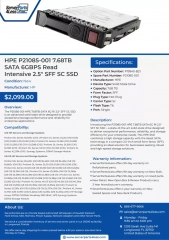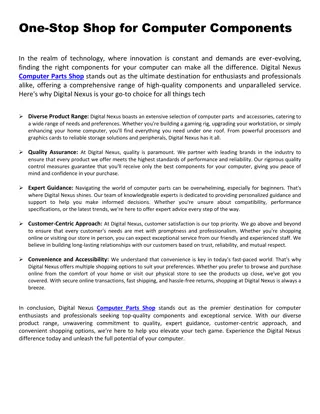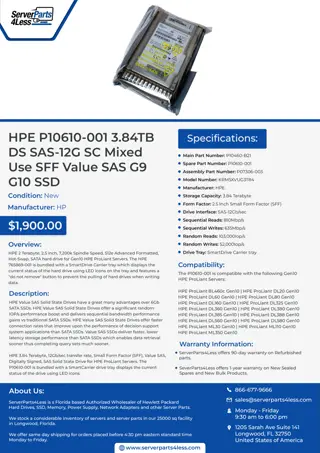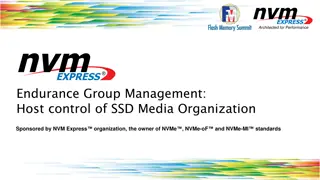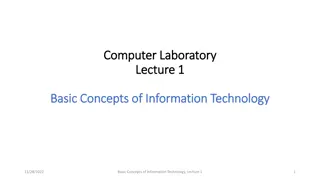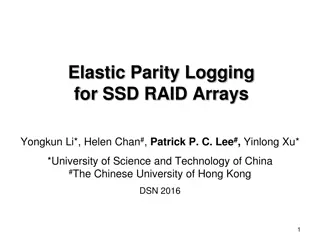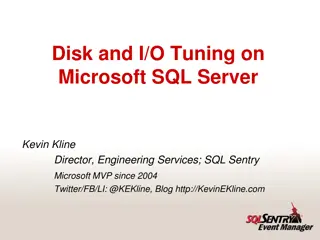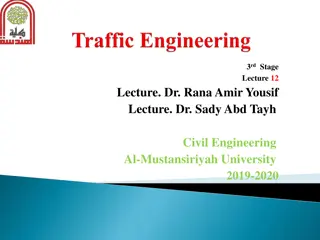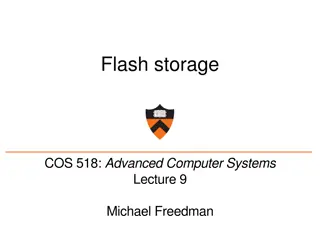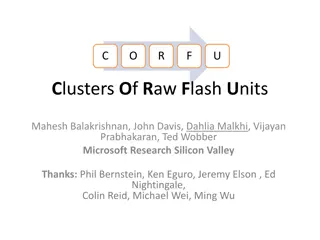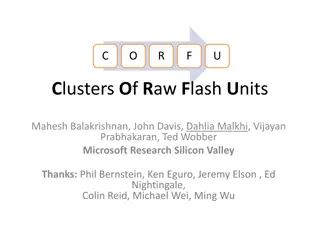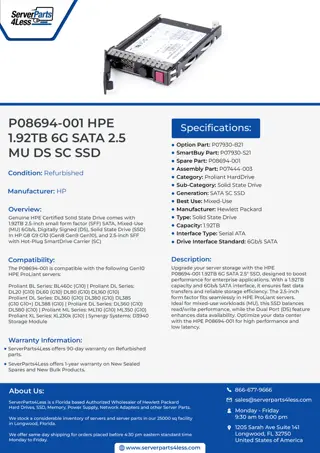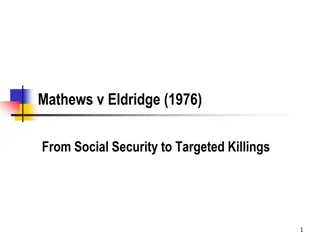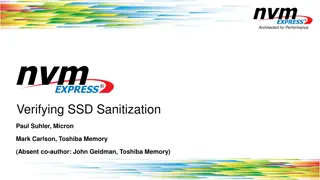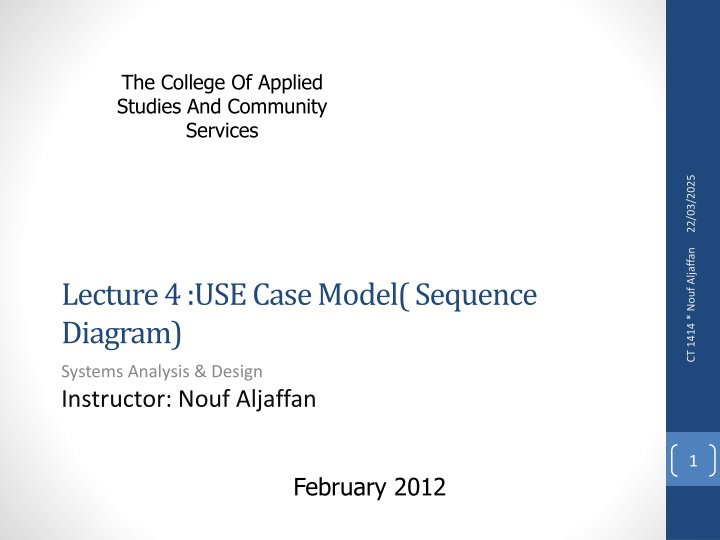
System Sequence Diagram: Understanding Use Cases and System Events
Explore the concept of system sequence diagrams to better understand use cases and system events in software development projects. Learn how these diagrams illustrate input and output events related to the systems under discussion, helping to define system behavior effectively.
Download Presentation

Please find below an Image/Link to download the presentation.
The content on the website is provided AS IS for your information and personal use only. It may not be sold, licensed, or shared on other websites without obtaining consent from the author. If you encounter any issues during the download, it is possible that the publisher has removed the file from their server.
You are allowed to download the files provided on this website for personal or commercial use, subject to the condition that they are used lawfully. All files are the property of their respective owners.
The content on the website is provided AS IS for your information and personal use only. It may not be sold, licensed, or shared on other websites without obtaining consent from the author.
E N D
Presentation Transcript
The College Of Applied Studies And Community Services 22/03/2025 CT 1414 * Nouf Aljaffan Lecture 4 :USE Case Model( Sequence Diagram) Systems Analysis & Design Instructor: Nouf Aljaffan 1 February 2012
22/03/2025 CT 1414 * Nouf Aljaffan 1. 2. 3. 4. SSD Definition SSD Notation Developing a System Sequence Diagram CASE STUDY OUTLINE 2
Initiation UML Framework Feasibilty Study Scope of Development - domain description - boundaries Requirements Capture Use Cases Use Case Diagram 22/03/2025 Requirements Analysis System Design Domain Model Implementation Design Model Software Architecture * sub-systems * layers & partitioning Object Design Use Cases Use Case Diagram Domain Model Use Cases Use Case Diagram CT 1414 * Nouf Aljaffan Class Diagram Data Dictionary CRCs Interaction Sequence Diagram Collaboration Diagram Operation Specifications Statecharts static view redrawn/extended class diagram to reflect design decisions: addition of interface and control objects; addition of constraints, etc. Class Diagram Data Dictionary CRCs Interaction Sequence Diagram Collaboration Diagram Operation Specifications Statecharts dynamic view Interface Design * Presentation Layer Data Management * Storage mechanisms UML Framework 3
22/03/2025 CT 1414 * Nouf Aljaffan 4
Introduction System Sequence Diagram A system sequence diagram is a fast and easily created artifact that illustrates input and output events related to the systems under discussion 22/03/2025 CT 1414 * Nouf Aljaffan Before proceeding to a logical design of how a software application will work, we should investigate and define the system behavior as a "black box . 5
System Event and Response Use cases describe how external actors interact with the software system. 22/03/2025 During this interaction an actor generates events to a system, usually requesting some operation in response. CT 1414 * Nouf Aljaffan For example, when a cashier enters an item's ID, the cashier is requesting the POS system to record that item's sale. That request event initiates an operation upon the system. 6
System sequence diagram A system sequence diagram(SSD) is a picture that shows, for a particular scenario of a use case, the events that external actors generate, their order, and inter-system events. The emphasis of the diagram is events that cross the system boundary from actors to systems. An SSD should be done for the main success scenario of the use case, and frequent or complex alternative scenarios. An SSD is generated from inspection of a use case Suggestion: One SSD one Use Case 22/03/2025 CT 1414 * Nouf Aljaffan 7
Identifying Inputs and Outputs the System Sequence Diagram System sequence diagram (SSD) 22/03/2025 Describes flow of information Identifies interaction between actors and system CT 1414 * Nouf Aljaffan Message oriented 8
SSD Notation Actor interacts with the system via input/output SSDs use object notation Box (rectangle) refers to individual object Name of the object underlined Lifeline is a vertical line under object or actor to show passage of time for object Indicates sequence of the messages sent/received If vertical line dashed Creation and destruction of thing is not important for scenario Long narrow rectangles Activation lifelines emphasize that object is active only during part of scenario 22/03/2025 CT 1414 * Nouf Aljaffan 9 Message is labeled on arrows to show messages sent to or received by actor or system
22/03/2025 CT 1414 * Nouf Aljaffan Figure 6-14 10 Sample System Sequence Diagram
SSD Notation (continued) Message syntax can take several forms 22/03/2025 Depends on send/return direction Message semantics: actions (like commands) invoked on destination object CT 1414 * Nouf Aljaffan Complete message notation:*[true/false condition] return- value := message-name (parameter-list) 11
22/03/2025 CT 1414 * Nouf Aljaffan Figure 6-15 12 Repeating Message (A) Detailed Notation (B) Alternate Notation
Developing a System Sequence Diagram Begin with detailed description of use case Fully developed form Activity diagrams ( out of our subject) (4) step process for turning activity diagram or UC Description into SSD [1] Identify the input messages [2] Describe messages from external actor to system [3] Identify/apply special conditions to input messages [4] Identify and add the output return messages 22/03/2025 CT 1414 * Nouf Aljaffan 13
Activity Diagram and Resulting SSD for Telephone Order Scenario 14
Case Study: How to do SSD in the POS Project Simple cash-only Process Salescenario: 1. Customer arrives at a POS checkout with goods and/or services to purchase. 2. Cashier starts a new sale. 3. Cashier enters item identifier. 4. System records sale line item and presents item description, price, and running total. Cashier repeats steps 3-4 until indicates done. 5. System presents total with taxes calculated. 6. Cashier tells Customer the total, and asks for payment. 7. Customer pays and System handles payment. ... 22/03/2025 CT 1414 * Nouf Aljaffan 15
22/03/2025 CT 1414 * Nouf Aljaffan Step 1: Define System Events and the System Boundary 16 the system boundary is usually chosen to be the software system itself; in this context, a system event is an external event that directly stimulates the software
22/03/2025 CT 1414 * Nouf Aljaffan Step 2: Naming System Events and Operations 17
Step 3: show Use Case Simple cash-only Process Salescenario: 1. Customer arrives at a POS checkout with goods and/or services to purchase. 2. Cashier starts a new sale. 3. Cashier enters item identifier. 4. System records sale line item and presents item description, price, and running total. Cashier repeats steps 3-4 until indicates done. 5. System presents total with taxes calculated. 6. Cashier tells Customer the total, and asks for payment. 7. Customer pays and System handles payment. ... 22/03/2025 CT 1414 * Nouf Aljaffan 18
22/03/2025 CT 1414 * Nouf Aljaffan Step 4: Do SSD 19
22/03/2025 CT 1414 * Nouf Aljaffan SSD of UC - Process Sale 20
Integrating Object-Oriented Models Complete use case diagram is needed to understand total scope of new system Domain model class diagrams should also be as complete as possible for entire system With iterative approach, only construct use case descriptions, activity diagrams, and system sequence diagrams for use cases in iteration Development of a new diagram often helps refine and correct previous diagrams 22/03/2025 CT 1414 * Nouf Aljaffan 21
22/03/2025 CT 1414 * Nouf Aljaffan 22
22/03/2025 CT 1414 * Nouf Aljaffan Relationships Between OO Requirements Models 23

